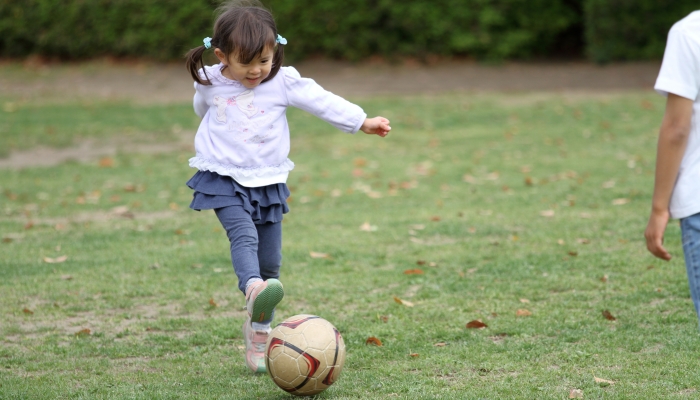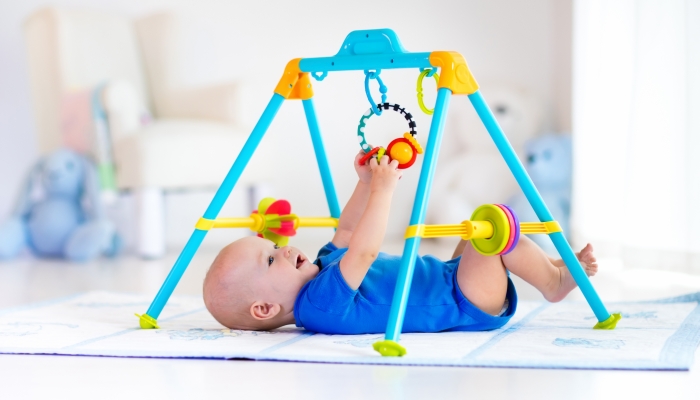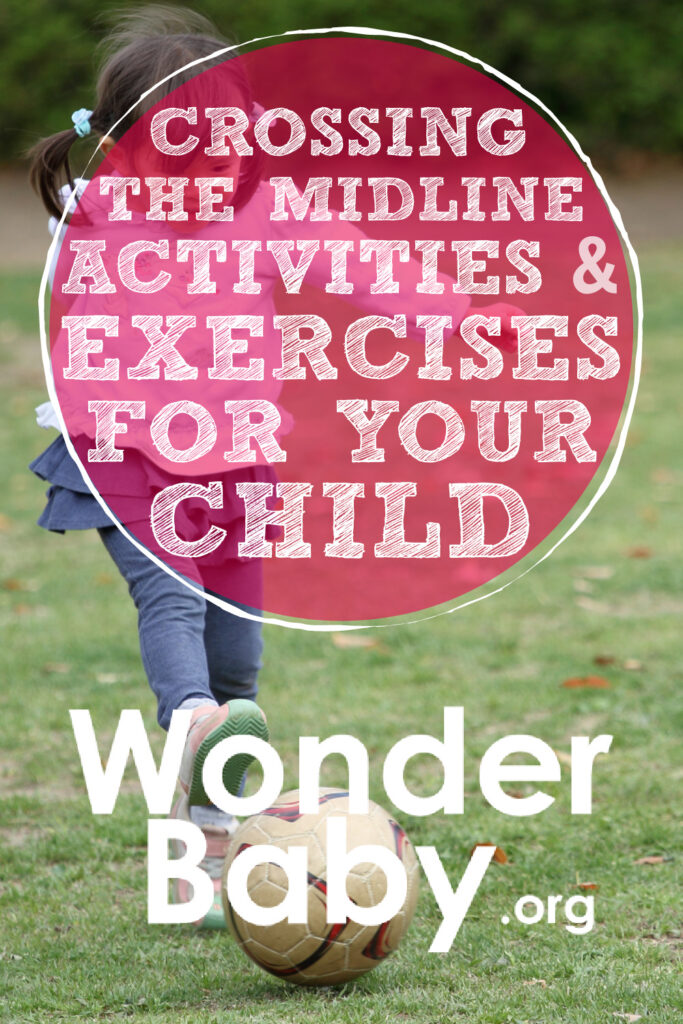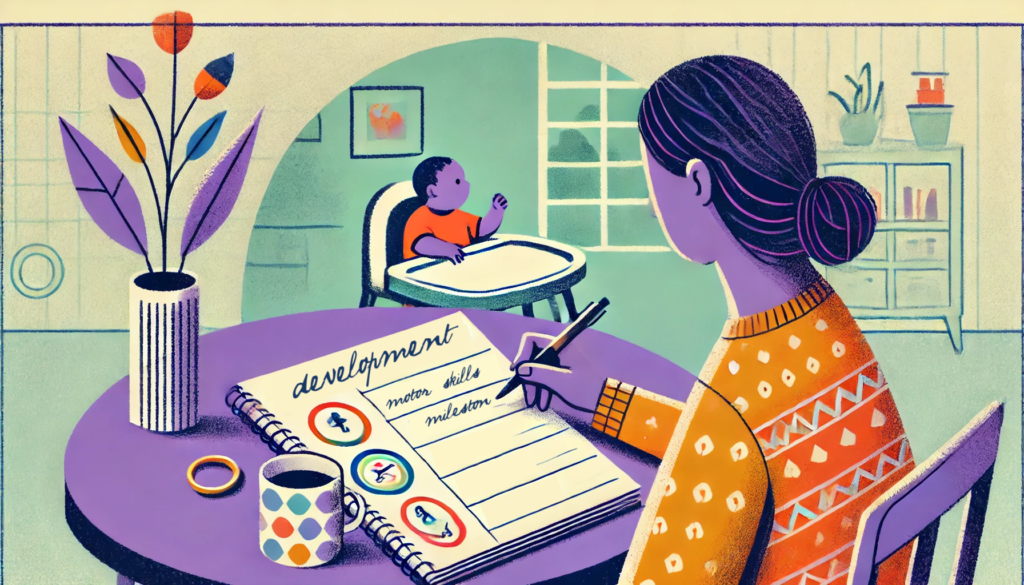Crossing the Midline Activities & Exercises for Your Child

This post may contain affiliate links; please see our terms of use for details.
- Children begin reaching across the midline of their bodies in infancy and continue to develop the skill throughout childhood.
- Crossing midline is an important part of developing motor skills, self-care skills, and the ability to participate in hobbies, sports, and play activities.
- Difficulty with crossing midline can indicate developmental delay, coordination problems, or issues with the nervous system and should be discussed with your child’s healthcare provider.
Does it seem like your baby already has a dominant hand and only wants to use one side all the time? Or does your older child have difficulty reaching across their body to catch a ball or pop a bubble?
These concerns may indicate difficulty crossing midline or moving body parts across an imaginary line that divides the body in half.
Crossing the Midline: What You Should Know
The body’s midline is an imaginary line that runs down the center of a person, splitting the body into left and right sides.
Performing everyday tasks often requires that we cross midline, or move our hand or foot from its side of the body to the opposite side. For example, when cleaning, we will move our hand across our body to reach a dirty spot on the other side of the table.
Often it’s the dominant hand or foot that crosses midline since we are more comfortable doing motor tasks with our preferred side. We should be able to cross midline with either hand or foot and perform tasks on both sides of the body using the opposite hand.
Bilateral coordination is the ability to use both sides of the body together to accomplish a task and is an essential part of child development.

How Important Is Crossing the Midline in Child Development?
Crossing midline is an important precursor to your child learning other skills. In infancy, reaching to the opposite side leads to the trunk rotation necessary for a baby to roll over. Being able to cross the midline is also important for learning to perform daily tasks and participating in play activities like ball sports, dance, and crafts.
Trouble crossing midline may delay fine and gross motor skills since many skills like rolling, crawling, walking, and using tools require the coordinated use of both sides of the body. These skills can be taught at any time during childhood, but are most easily developed in the first five years of life.
Since crossing midline requires the use of both the left and right hemispheres of the brain, practicing these skills helps your brain to work in a coordinated fashion.
Strong connections between the sides of the brain can also have positive effects on:
- Executive function
- Improving attention
- Language
- Decision-making
Thus, crossing the midline is essential for many functions of the body and brain.
If your child cannot cross midline after early infancy, you should discuss this with their healthcare provider. Being unable to cross midline may be indicative of neurological injury or other dysfunction of the body.
How Does the Ability to Cross the Midline Develop?
Children may begin crossing the midline in early infancy. This skill develops gradually over time and won’t resemble mature, coordinated movements at this stage.
Typically, infants will reach for a non-moving object with the hand on the same side but may use one or both hands moving across midline to try and grasp an object that is moving. Infants may not grasp a moving object successfully, but midline crossing should still be encouraged!
Babies also may not have a preferred hand or show hand dominance and should practice equally on both sides by switching hands during reaching and grasping activities. Reaching to both sides, not just one, is important for the normal development of fine and gross motor skills.
Crossing midline activities will also help your baby learn to:
- Roll
- Develop core strength
- Improve visual tracking
- Strengthen both arms and both sides of their neck
When babies only use one side of the body or avoid crossing midline, this can lead to asymmetrical crawling or rolling and delayed fine and gross motor skills.
As your baby demonstrates increasing hand dominance during their toddler and early childhood years, they may be more likely to spontaneously cross midline to use or reach for objects with their preferred hand. Most often, the right hand is dominant, but it is not abnormal or a cause for concern for a child to prefer using their left hand.
As your child ages, they should be comfortable performing tasks that cross the midline without assistance or difficulty. This skill becomes increasingly faster and more accurate in early to middle childhood and should be mature by adolescence.

How to Tell if Your Child Has Trouble Crossing the Midline
Noticing problems crossing midline may be difficult at first since it is not a commonly referenced skill set. There are some signs that indicate your child is having difficulty crossing midline. If you notice any of the following, please share your concerns with your child’s pediatrician:
Visual Neglect of One Side
If your child does not pay attention to one side of their body and seems not to see or notice objects on that side, they are likely not crossing midline toward that side either. Visual neglect can indicate serious issues with the visual or nervous system and should be addressed with your child’s provider.
Asymmetry in Motor Skills
Your child may uses the same hand or foot for all tasks or displays asymmetry in the performance of early motor skills.
Poor Coordination of Ball Skills
This may include:
- Difficulty moving both hands to an object to hit or catch, especially across the body
- Difficulty kicking a moving ball
- Lack of trunk rotation when throwing or kicking (ages 4 or older)
- Inability to dribble from side to side with hands or feet
Difficulty Completing Activities of Daily Living
This might look like:
- Switching hands to do tasks on the opposite side (e.g., using left hand to brush teeth on left side and right hand to brush teeth on right side)
- Inability to reach to clean spots across the body
- Difficulty using both hands to put on socks and shoes or difficulty with crossing legs

10 Activities & Exercises to Develop Your Child’s Crossing Midline Skills
There are many exercises you can do with your child to get them to cross the midline in a fun way, including hand-eye coordination games, sports, and crafts.
1. Pool Noodle Fights
Fun for older kids, this activity encourages using both hands across the body to swing the noodle from side to side.
2. Hand Games
Traditional hand games like Pat-a-cake, Miss Mary Mack, etc., are great for crossing midline. Bonus points if you clap opposite hands with your child during these activities!
3. Simon Says
Parents get to break out their creativity with this game where your child must imitate your movements. Emphasize moves that reach across the body with the opposite hand or foot.
4. Bead Games and Crafts
Moving objects across a line or string encourages children to reach smoothly across their body and track objects with their eyes. This activity has many variations, from counting on an abacus to playing with a bead maze or making a pretty necklace.
5. Karaoke or Grapevine
Do this classic activity by crossing legs in an alternating fashion while moving your body to one side. The grapevine is easier for grade school children to replicate and may be too advanced for most toddlers.
6. Toe Touches
This fun exercise involves rotating your body to touch your toe with your opposite hand. Switch from side to side so both sides get practice!
7. Ball Skills
- Throwing: Practice having your child step with the opposite foot and rotate their trunk while moving the arm across the body.
- Kicking: As with throwing, have your child step with the opposite foot before bringing the leg back and forward, following through by crossing the midline.
- Dribbling: Practicing both basketball and soccer-style dribbling are great crossing midline exercises. At first, your child will just practice meeting their hand or foot with the ball without losing it, but with practice, they should be able to bounce or kick the ball from side to side.
8. Twister
This old-school board game can keep your child busy for hours and will encourage crossing midline, developing visuospatial skills, and color identification.
9. Playing an Instrument
Some of the most advanced fine motor skills include the ability to master playing a musical instrument. While piano lessons may not be an option for very small children, practicing drumming, using a xylophone, or tapping on piano keys will encourage your child to naturally cross midline.
10. Reaching Activities
- Infants: Babies love toys that light up and make noise, particularly if the visual contrast is high (think bright and bold or black and white). Encouraging your baby to reach for toys is one of the earliest development skills that also leads to grasping and rolling. Remember to have them reach to each side and across the body with both hands.
- Pegboard: Playing with a pegboard may require adult help if the goal is crossing midline. Make sure to tell your child which hand to use to reach for which pegs. You may make a game out of it by increasing the speed or having your child create a picture or message. For alternatives to a traditional pegboard, you can use stickers or toys that stick to your windows or doors.
- Balloon Keep Up: Children love to see who can keep a balloon in the air the longest! While chasing and reaching after the balloon, they won’t even realize they are doing an “exercise.”
- CLASSIC SORTING & STACKING LEARNING TOY – The Play Brainy peg toy set is a classic Montessori style toddler’s learning toy for children ages 3-5 to that helps them learn how to count, learn color composition, and much more while still having fun.
- COMPLETE STACKING PEG TOY SET – This peg board set comes with everything your child needs to start learning and having fun. It includes 30 durable plastic pegs, 1 foam peg board, 1 carry bag to keep everything in, and a set of simple instructions.
- TEACHES COLOR MATCHING & RECOGNITION – With all 30 of our pegs coming in 6 different colors such as green, yellow, orange, red, purple, and blue, our stacking peg toy is perfect for helping your child learn to recognize and match colors while they play.
- DEVELOPS IMPORTANT MOTOR SKILLS – Our peg board set is also a fantastic learning toy for helping toddlers and young children develop important motor skills such as hand-to-eye coordination, visual perception skills, and visual motor coordination.
FAQs
Can trouble with crossing the midline during infancy lead to problems in adulthood?
Problems crossing midline in infancy can potentially lead to problems in adulthood. Bilateral coordination skills can be improved during childhood, so problems seen in infancy do not necessarily predict long-term problems.
A physical or occupational therapist can help your child improve their ability to cross the midline. The long-term effects of difficulty crossing midline may include poor coordination, poor posture, strength imbalances, and decreased efficiency and speed when doing daily activities or participating in sport.
Do problems with crossing the midline indicate medical problems?
While difficulty crossing midline may indicate damage to the brain or issues with coordination, these problems can also be attributed to an early environment that was unstable and did not provide opportunities for the child to practice early motor skills.
If you are a provider or teacher and notice problems with midline crossing among your patients or students, do not automatically assume that the child has a medical problem. An evaluation by a healthcare provider can reveal underlying medical diagnoses if they are present.

The information WonderBaby provides is not intended to be, and does not constitute, medical or other health advice or diagnosis and should not be used as such. Always consult with a qualified medical professional about your specific circumstances.
Related Posts

Development, Special Needs
How to Track Milestones for Developmentally Delayed Babies
Parents of developmentally delayed babies can explore practical tools and strategies to track milestones, celebrate progress, and support their child’s unique developmental journey.

Fine and Gross Motor
5 Alternatives to Tummy Time for Babies with Motor Development Challenges
Does your baby struggle with tummy time due to motor development challenges? These alternatives to tummy time will offer the same benefits.

Development
Should Twins Share a Room?
Wondering if your twins should share a room? We’ll explore the pros and cons of room-sharing for twins right here before you make your decision.
